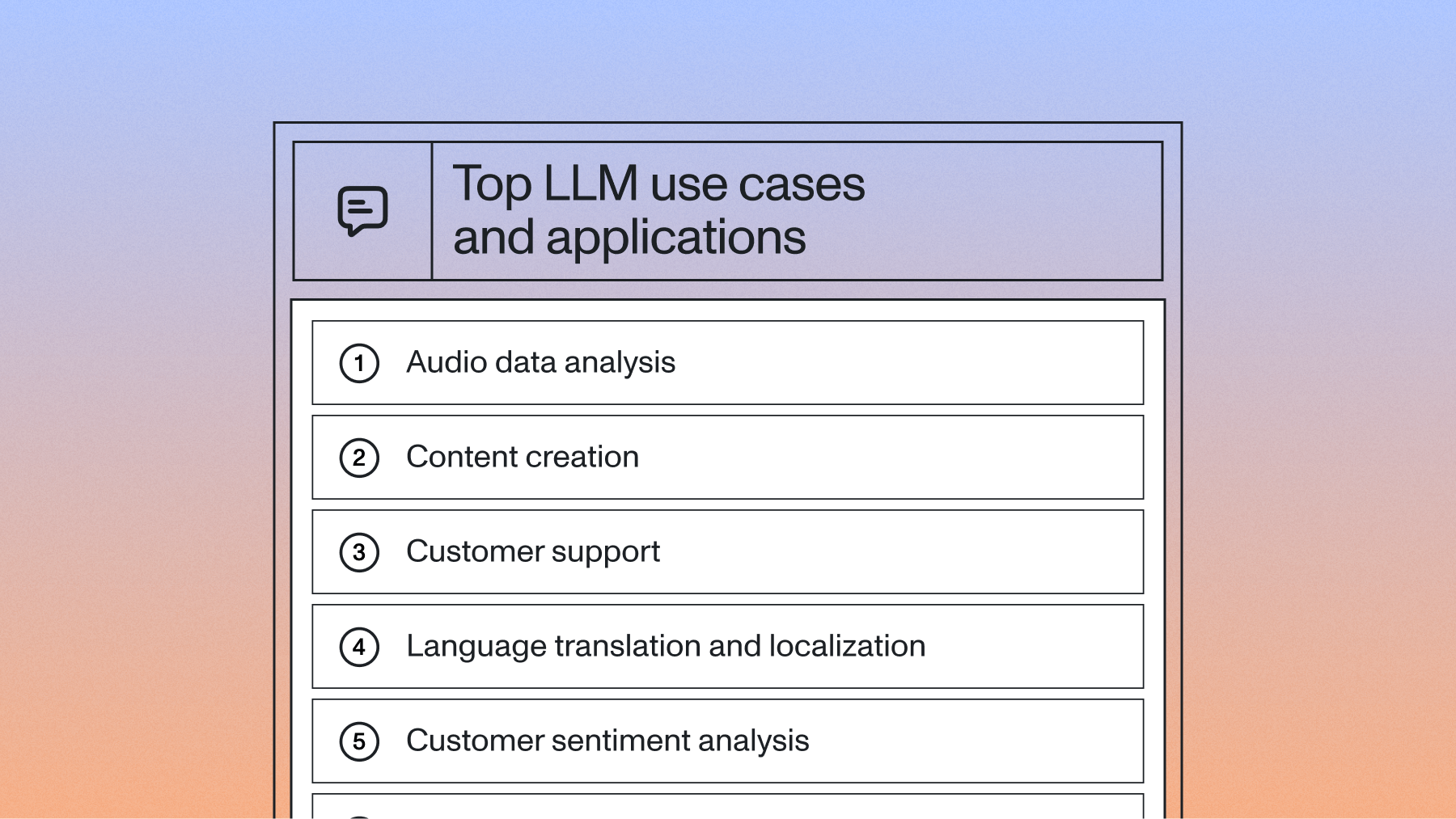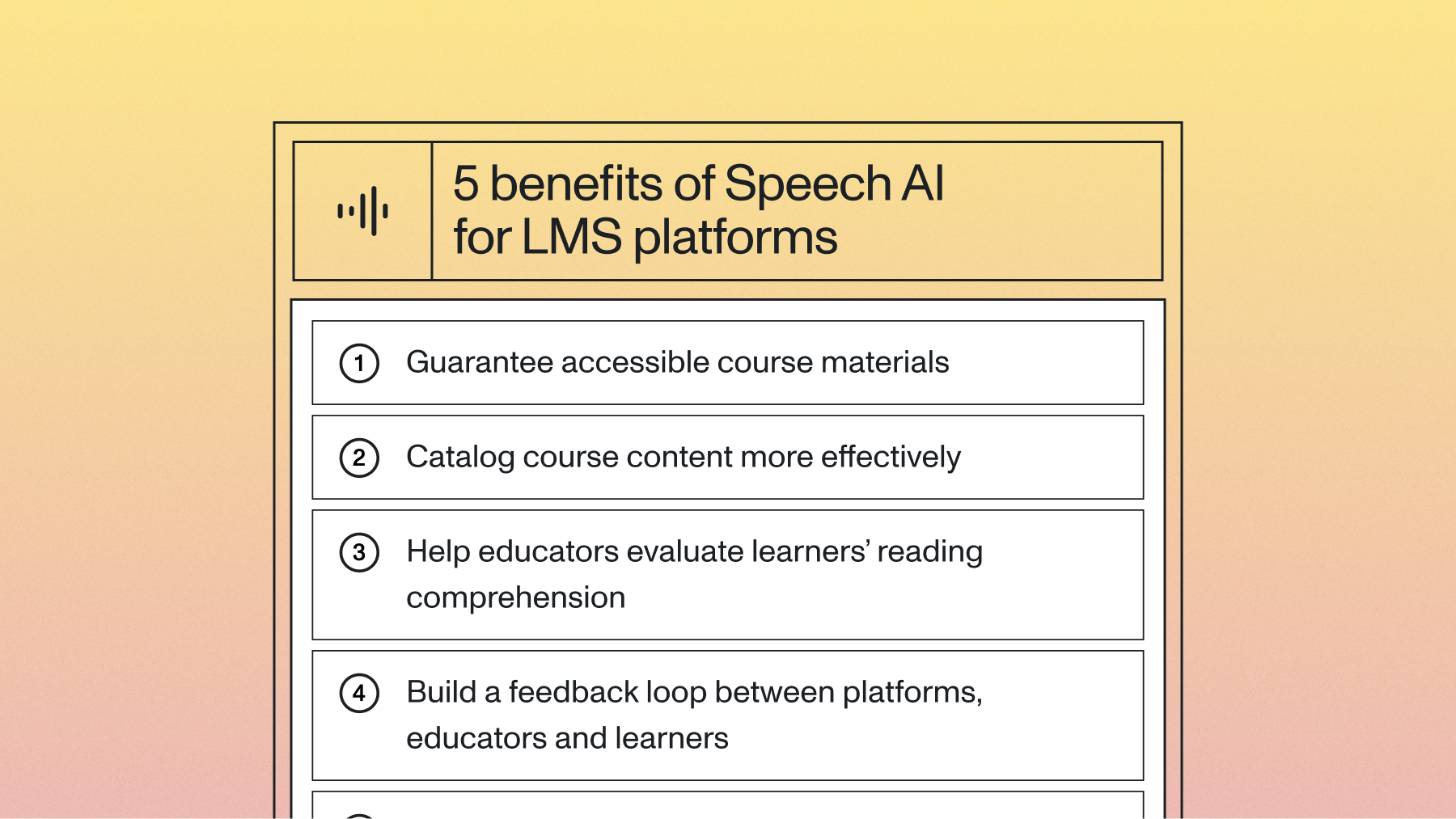Speech-to-Text AI for Product Managers: How It Works and Key Considerations
Learn how speech-to-text AI technology works and read about key considerations when weighing your options.



Speech-to-text, also known as Automatic Speech Recognition (ASR), is exactly what it sounds like—converting spoken words into written words. Though speech-to-text is a simple concept, the AI technology behind it is robust. Learn how speech-to-text works, and read about key considerations when weighing your options.
How Does Speech-to-Text AI Work?
Most modern speech-to-text methods involve End-to-End Deep Learning to directly route an acoustic waveform into a sequence of words. Typically, large quantities of data are required to train the AI model to create accurate speech-to-text transcriptions. Without this level of training, the transcriptions will be much less accurate and useful. AI technologies are rapidly improving, so it’s important to select Speech-to-Text AI technology that’s built by a team of expert researchers who continuously evaluate, train, and deploy new neural networks as new artificial intelligence breakthroughs emerge. Without constant improvements to keep up with changes in AI technology, you risk leveraging outdated AI models.
Learn in more detail how Speech-to-Text AI technology works: What is ASR? A Comprehensive Overview of Automatic Speech Recognition Technology.
Now that you have an idea of how Speech-to-Text AI technology works and the importance of selecting one that is high-quality, let’s look at key considerations to keep in mind.
What to Look for in Speech-to-Text AI
When evaluating Speech-to-Text AI technology, there are a number of factors to consider. Take a look at the criteria below to determine what is most important for your use case.
Near human-level accuracy
Transcription accuracy is one of the most important qualities of speech-to-text software. If the transcription is inaccurate and changes the meaning of what is said, then the user has to go back to the audio to better interpret the context of the conversation. Accuracy ensures that the user saves time using speech-to-text software.
When looking at speech-to-text models, the accuracy should be as close to human level as possible. Also check to see if the AI model has an array of valuable features like:
- Automatic punctuation, casing, and alphanumerics: Automatically add the casing of proper nouns and have the model incorporate punctuation for natural sentences, listicles, and alphanumerics.
- Speaker diarization: Detect the number of speakers within the audio file and associate each word within the transcript to a speaker. This can be incredibly helpful for calls that have several speakers.
- Noise robustness: Accurately transcribe with background or extraneous noise. Conformer-2 shows a 12% improvement over Conformer-1 in noise robustness,
- Confidence scores: Receive a confidence score for each word within the transcript. A low confidence score can tell a user that the word may have been interpreted incorrectly. The client program can then create a logic to handle low confidence words depending on the application scenario it serves.
Customization and spoken language understanding with LLMs
Customization features can help businesses personalize the speech-to-text software for their use cases. For example, if a business has custom terms, such as the name of the business, products or features, it can be helpful to note specific spellings or vocabulary for the speech-to-text AI model to process.
- Custom spelling: Customize how words are spelled or formatted in the transcription text.
- Custom vocabulary: Boost the accuracy of your transcripts by adding custom vocabulary to your API request that is unique to your business.
- Profanity filtering: Automatically detect and replace profanity within the transcription text.
You’ll also want to see if the speech-to-text AI solution has additional features or models you can incorporate—such as audio redaction models to help businesses automatically redact personally identifiable information from text transcripts.
Additionally, by pairing speech-to-text APIs with Large Language Model (LLM) frameworks, businesses can build LLM apps on spoken data that search, summarize, and generate text with your spoken content.
Multiple languages
If you’re building a model for international usage, you’ll likely want multiple language support, so look for an AI model that can support 20 or more languages.
You may also want to look for automatic language detection, which can identify the dominant language spoken in an audio file and automatically route it to the appropriate model for that language.
Transcription speed
When you’re working with large quantities of audio files, speed becomes essential. Look for an asynchronous transcription API that transcribes recorded audio and video content and transcribes at approximately 5x the real-time speed of audio. In addition to asynchronous transcription, consider a real-time transcription API with high accuracy and low latency so you’ll get results in a matter of milliseconds.
Consistent innovation, updates, and ease of integration
Is there a team of engineers constantly working through bugs, improving accuracy, and developing the latest and greatest enhancements? AI technology is changing rapidly, and if there isn’t a team focused on improving and innovating with the software, then the software likely isn’t a good long-term solution.
Look for a solution with a dedicated engineering team as well as dedicated resources. Check to make sure the solution has weekly product and accuracy improvements, extensive documentation, and video tutorials to ensure there’s ease of use for developers.
Ability to scale as your business grows
Another consideration when weighing your speech-to-text API options is its ability to scale. Here are a few questions to consider:
- Does the technology have the bandwidth to process thousands (even millions) of files? You may not need this quantity of transcription currently, but you may down the line.
- Does it offer in-house support? As the business grows, you may need to lean on AI experts for additional support.
- What is the uptime? Look for models that offer 99.99% uptime, so you can build with confidence.
- Is the software following security best practices? A company that prioritizes security, such as SOC 1 and 2 compliance and third party audits, offers peace of mind that the audio you’re transcribing is protected.
If you’re looking for a solution that scales with you, look for one that can process millions of files daily, has 24/7 support from support engineers and technical account managers, has 99.9% uptime and enterprise-grade security.
Free speech-to-text software vs paid plans
One of the biggest considerations is cost. There are a few free speech-to-text options on the market which can be a great solution if you’re looking to test how speech-to-text can enhance your business.
However, if you’re looking for a long-term solution that can handle hundreds of thousands of hours of audio with high accuracy, then a free solution may not be the right fit. Free speech-to-text solutions also require more legwork on your end to tailor the toolkit to your needs.
If you’re unsure whether a paid plan is worth it, look for a free trial, free tier or speech-to-text playground to test the speech-to-text software first.
Lorem ipsum dolor sit amet, consectetur adipiscing elit, sed do eiusmod tempor incididunt ut labore et dolore magna aliqua. Ut enim ad minim veniam, quis nostrud exercitation ullamco laboris nisi ut aliquip ex ea commodo consequat. Duis aute irure dolor in reprehenderit in voluptate velit esse cillum dolore eu fugiat nulla pariatur.




%20is%20Being%20Used%20Today.png)